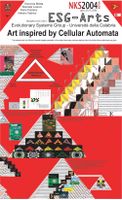She was a little bit of a stranger in the team as all the other participants were people studying multimedia production. She studied and still studies mathematics and is a multimedia artist interested in combining art and science/technology. Yet asked for research areas of interest, she will tell you: Electronic and Generative Art; Storytelling; Interactive media; Communication and new technologies or if you want to have it in other terms: Computer Graphics & Virtual Reality; Educational Technology; Electronic Art; Visual Arts, Film studies & special effects; Digital sound processing, Linguistics. Altogether, she covers a broad field.

Menu page of CD-ROM
The CD-ROM, which has been produced by her, is a CD-ROM on Mathematics, Arts and Cultural Industry. This is a very wide area. The CD-ROM contains the proceedings of a September mini conference held at an island near Venice and the proceedings of a national conference in May held at Cetraro. It contains papers, but also multimedia, ranging from photographs to videos and music. But the CD-ROM contains also multimedia presentations such interactive movies with 3D figures and sounds as well as presentations of virtual museums. I have been scanning through the papers and the multimedia assets with a lot of interest. The menu of the CD-ROM is bilingual in Italian and in English and the papers are also in English.
It is funny to see mathematicians busy with art and the cultural industry. Their point of departure is quite different from people that have studied art or cultural management. I expected to see somewhere a link to Escher, a Dutch artisan who put mathematical riddles into his painting. But also with the music you do not expect baroque, but some strange sounds. Well people interested in this are fully served by this CD-ROM.

Poster on maths and art

No comments:
Post a Comment